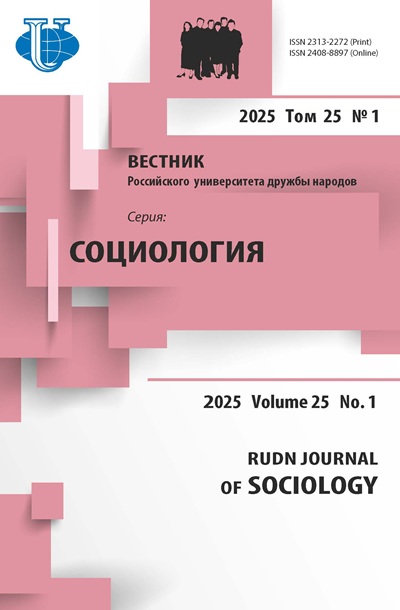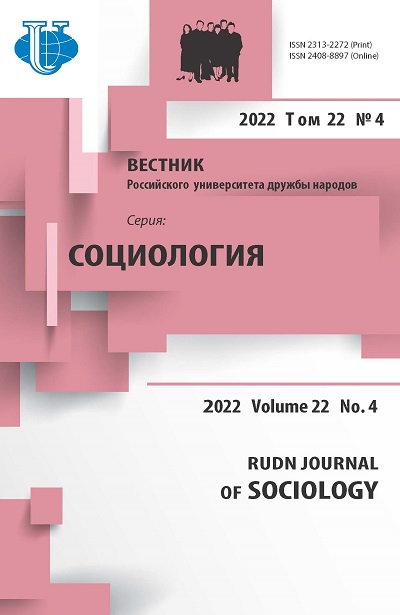Wealth concentration and the ‘patrimonial middle class’ in the contemporary European-American civilization
- Authors: Čižo E.1, Menshikov V.1, Kokarevica A.2, Selivanova-Fyodorova N.3
-
Affiliations:
- Daugavpils University
- Riga Stradinsh University
- RISEBA University of Applied Sciences
- Issue: Vol 22, No 4 (2022)
- Pages: 919-936
- Section: Sociological lectures
- URL: https://journals.rudn.ru/sociology/article/view/33220
- DOI: https://doi.org/10.22363/2313-2272-2022-22-4-919-936
Cite item
Full Text
Abstract
The study aims at the comparative analysis of the trends in wealth concentration and formation of the ‘patrimonial middle class’ (the term by Piketty) in the countries of the contemporary European-American civilization (EAC). T. Piketty suggests that wealth concentration is increasing again (as in the 18th - 19th centuries), and the formation of the ‘patrimonial middle class’ is the most significant structural change in the long-term wealth distribution. The authors chose five parts of the EAC from West to East: USA, Western Europe, Latvia, Ukraine, and Russia. To measure and compare wealth inequality, the authors used statistical deciles: the top 10 % (including the top 1 %), the middle 40 % and the bottom 50 % of the population. 1995 and 2021 were chosen as time points for the diachronic analysis of the data from the World Inequality Database. The study results show that in different parts of the contemporary EAC, wealth concentration and the formation of the ‘patrimonial middle class’ differ in pace and sometimes in direction: from rapid concentration to deconcentration. Wealth concentration in the hands of the top 1 % of Americans has increased over the past 26 years from 28 % to 35 %, of Russians - from 21 % to 48 %. According to Piketty, such a situation (especially as in Russia) is a harbinger of social revolution. In terms of the wealth concentration level, Latvia and Ukraine represent an intermediate case between Western Europe and the USA/Russia. At the same time, the USA, Western Europe and Russia differ greatly in the cultural-value perspective. The authors question the united EAC in the 21st century and define it as split into an ‘initial core’ (European civilization) and two constantly conflicting ‘peripheries’ (American and Russian civilizations).
About the authors
E. Čižo
Daugavpils University
Author for correspondence.
Email: edmunds@chemi-pharm.com
Vienibas St., 13, Daugavpils, LV-5401, Latvia
V. Menshikov
Daugavpils University
Email: vladimirs.mensikovs@du.lv
Vienibas St., 13, Daugavpils, LV-5401, Latvia
A. Kokarevica
Riga Stradinsh University
Email: anita.kokarevica@rsu.lv
Dzirciema St., 16, Riga, LV-1007, Latvia
N. Selivanova-Fyodorova
RISEBA University of Applied Sciences
Email: nsel15@inbox.lv
Meza St.,3, Riga, LV-1048, Latvia
References
- Akaliyski P. United in diversity? The convergence of cultural values among EU member states and candidates. European Journal of Political Research. 2018; 2.
- Alvaredo F., Chancel L., Piketty T., Sae E., Zucman G. World Inequality Report 2018. URL: https://wir2018.wid.world/executive-summary.html
- Ankerl G. Global Communication without Universal Civilization. INU Societal Research. Vol. 1: Coexisting contemporary civilizations: Arabo-Muslim, Bharati, Chinese, and Western. Geneva; 2000.
- Bakvis P. The World Bank’s fuzzy math on inequality and the future of work. 2018. URL: https://inequality.org/research/world-banks-fuzzy-math-on-inequality-and-future-of-work
- Bova R. Russia and Western Civilization. Cultural and Historical Encounters. Routledge; 2003.
- Bourguignon F. The Globalization of Inequality. Princeton University Press; 2015.
- Business School for the World: The Global Talent Competitiveness Index 2019: Entrepreneurial Talent and Global Competitiveness. Lanvin B., Monteiro F. (Eds.). Paris; 2019.
- Danilevsky N.Y. Rossiya i Evropa [Russia and Europe]. 1869/2004. URL: http://vehi.net/danilevsky/rossiya/index.html. (In Russ.).
- Dubina I.N., Carayannis E.G., Campbell D.F.J. The coevolution of labor and creativity: A way from the “old” to the “new” economy. Bast G., Carayannis E., Campbell D. (Eds.) The Future of Education and Labor. Arts, Research, Innovation and Society. Cham; 2019.
- Dugin A. Osnovy geopolitiki. Geopoliticheskoe budushchee Rossii [Foundations of Geopolitics. Geopolitical Future of Russia]. Moscow; 1997. (In Russ.).
- Eshe N. Thomas Piketty says the US is setting a bad example on inequality for the world. 2017. URL: https://qz.com/1155448/thomas-piketty-says-the-us-is-setting-a-bad-example-oninequality-for-the-world.
- Flaherty T.M., Rogowski R. Rising inequality as a threat to the liberal international order. International Organization, 2021; 2.
- Fujita M., Thisse J. The Economics of Agglomeration. Cambridge University Press; 2002.
- Galle S., Rodriguez-Clare A., Yi M. Slicing the pie: Quantifying the aggregate and distributional effects of trade. 2017. URL: https://www.nber.org/papers/w23737.pdf.
- Haynes J. A Quarter Century of the “Clash of Civilizations”. Routledge; 2021.
- Hofstede G. Culture’s Consequences: Comparing Values, Behaviors, Institutions and Organizations across Countries. Thousand Oaks; 2001.
- Hofstede G. Country comparison. 2022. URL: https://www.hofstede-insights.com/country-comparison/latvia,russia,the-usa.
- Hung H.-F. Recent trends in global economic inequality. Annual Review of Sociology. 2021; 1.
- Huntington S.P. The clash of civilizations? Foreign Affairs, 1993; 3.
- Huntington S.P. The Clash of Civilizations and the Remaking of World. New York; 1996.
- Inozemtsev V.L. One World Divided. Existing Causes and Possible Results of the Coming Post-Economic Revolution. London; 2001.
- Institute for Policy Studies. Billionaire Bonanza: The Forbes 400 and the Rest of Us. 2017. URL: https://ips-dc.org/wp-content/uploads/2017/11/BILLIONAIRE-BONANZA-2017-FinalV.pdf.
- Institute for Policy Studies. Inequality. 2022. URL: https://inequality.org/about.
- Kerimoglu E., Karahasan B. Geography of talent for understanding regional disparities in Spain. Journal of Urban and Regional Analysis. 2012; 2.
- Kim S. Spatial inequality and economic development: Theories, facts and policies. Working Paper No. 16. Washington; 2008.
- Komarova V., Mietule I., Arbidane I., Tumalavičius V., Kokarevica A. Resources and capital of different social classes in modern Latvia. Journal of Eastern European and Central Asian Research. 2022; 3.
- Leikuma-Rimicane L., Komarova V., Lonska J., Selivanova-Fyodorova N., Ostrovska I. The role of talent in the economic development of countries in the modern world. Entrepreneurship and Sustainability Issues. 2021; 2.
- Mareeva S.V. Predstavleniya srednego klassa o neravenstvah na fone drugik rossiyan: consensus ili raskol? [Middle-class perceptions of inequality compared to other Russians: Consensus or disagreement?] Sotsiologicheskie Issledovaniia. 2021; 1. (In Russ.).
- Mareeva S.V., Slobodenyuk E.D. Neravenstvo v Rossii v mezhdunarodnom kontekste: dokhody, bogatstvo, vozmozhnosti [Inequality in Russia in the international context: Income, wealth, opportunities]. Vestnik Obshchestvennogo Mneniia. Dannie, Analiz, Diskussii. 2018; 1-2. (In Russ.).
- Martin R. The rise (and likely fall) of the talent economy. 2014. URL: https://hbr.org/2014/10/the-rise-and-likely-fall-of-the-talent-economy.
- Novokmet F., Piketty T., Zucman G. From Soviets to Oligarchs: Inequality and Property in Russia, 1905-2016. Cambridge; 2017.
- Paris School of Economics: World Inequality Database. 2022. URL: https://wid.world.
- Pew Research Center: Eastern and Western Europeans Differ on Importance of Religion, Views of Minorities, and Key Social Issues. 2018. URL: https://www.pewresearch.org/religion/2018/10/29/eastern-and-western-europeans-differ-on-importance-of-religion-viewsof-minorities-and-key-social-issues.
- Piketty T. Capital in the Twenty-First Century. Harvard University Press; 2014.
- Piketty T., Zucman G. Capital is back: Wealth-income ratios in rich countries 1700-2010. Quarterly Journal of Economics. 2014; 3.
- Reeskens T. Are Ukrainian values closer to Russia or to Europe? 2022. URL: https://blogs.lse.ac.uk/europpblog/2022/03/04/are-ukrainian-values-closer-to-russia-or-to-europe.
- Selivanova-Fjodorova N. Latvijas regionu ekonomiska diferentsiatsija 21 [Economic Differentiation of Latvia’s Regions at the Beginning of the 21st Century]. Doctoral Thesis. Daugavpils University; 2020. (In Latv.).
- Tao Zh., Zhang X., Malone K. Talent capital on economic growth: A tale of a Chinese megalopolis. International Journal of Applied Economics. 2017; 2.
- Tsygankov A.P. Russia’s Foreign Policy. Change and Continuity in National Identity. Lanham; 2006.
- World Income Inequality Database. 2022. URL: https://www.wider.unu.edu/project/world-income-inequality-database-wiid.
- World Inequality Report 2022. URL: https://wir2022.wid.world/www-site/uploads/2022/03/0098-21_WIL_RIM_RAPPORT_A4.pdf.
Supplementary files
There are no supplementary files to display.















